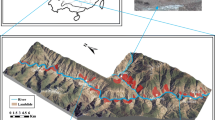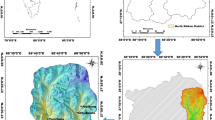Abstract
This study discusses the evaluation of the effect of using different weighting approaches in the process of landslide susceptibility assessment. Weighting process is needed, especially for landslide susceptibility assessment using bivariate statistical analysis, and can radically affect the resulting susceptibility map. The bivariate analysis belongs to a set of quantitative methods. The initial point for the bivariate analysis is selection and processing of input factors in the form of parametric maps, factors that play a dominant role in slope stability. The parametric maps were subsequently evaluated related to landslide inventory map. Another essential part of the bivariate analysis is the determination of the weight of the given input factors. Herein, four methods were applied to determine the weights of each class within reclassified input factors, as well as the total weight of the individual input factors. As a study area, the district of Kysucké Nové Mesto in Slovakia was chosen. Four prognostic maps were the result using entropy index, AHP method (AHP—analytic hierarchy process) (the input factors weighted as a whole), frequency ratio and landslide index (the weights were calculated for each class of input factor). Final landslide susceptibility maps were verified trough ROC curves (ROC—receiver operating characteristics). The accuracy of maps was ascertained by the size area (AUC—area under curve) under ROC curve. The highest accuracy was obtained for maps using weights calculated from the landslide index (88.5%) and the frequency ratio (88.4%).




Similar content being viewed by others
References
Aleotti P, Chowdhury R (1999) Landslide hazard assessment: summary review and new perspectives. Bull Eng Geol Environ 58:21–44. https://doi.org/10.1007/s100640050066
Ayalew L, Hiromitsu Y, Marui H, Kanno T (2005) Landslides in Sado Island of Japan: part II. GIS—based susceptibility mapping with comparisons of results two methods and verifications. Eng Geol 81:432–455. https://doi.org/10.1016/j.enggeo.2005.08.004
Barančoková M, Kenderessy P (2014) Assessment of landslide risk using GIS and statistical methods in Kysuce region. Ekológia 33:26–35. https://doi.org/10.2478/eko-2014-0004
Barančoková M, Krnáčová Z (2020) Assessment of landslide susceptibility using statistical modelling in the flysch zone of the Western Carpathians (NW Slovakia). Phys Geogr 41:1–28. https://doi.org/10.1080/02723646.2020.1770039
Bednarik M, Pauditš P (2010) Different ways of landslide geometry interpretation in a process of statistical landslide susceptibility and hazard assessment: Horná Súča (western Slovakia) case study. Environ Earth Sci 61:733–739. https://doi.org/10.1007/s12665-009-0387-8
Bednarik M, Magulová B, Matys M, Marschalko M (2010) Landslide susceptibility assessment of the Kraľovany–Liptovský Mikuláš railway case study. Phys Chem Earth 35:162–171. https://doi.org/10.1016/j.pce.2009.12.002
Bednarik M, Yilmaz I, Marschalko M (2012) Landslide hazard and risk assessment: a case study from the Hlohovec–Sereď landslide area in south-west Slovakia. Nat Hazards 64:547–575. https://doi.org/10.1007/s11069-012-0257-7
Cantarino I, Carrion MA, Goerlich F, Ibañez VM (2019) A ROC analysis—based classification method for landslide susceptibility maps. Landslides 16:265–282. https://doi.org/10.1007/s10346-018-1063-4
Choi J, Oh HJ, Lee HJ, Lee C, Lee S (2012) Combining landslide susceptibility maps obtained from frequency ratio, logistic regression, and artificial neural network models using ASTER images and GIS. Eng Geol 124:12–23. https://doi.org/10.1016/j.enggeo.2011.09.011
Constantin M, Bednarik M, Jurchescu MC, Vlaicu M (2011) The landslide susceptibility assessment using the bivariate statistical analysis and the index of entropy in the Sibiciu Basin (Romania). Environ Earth Sci 63:397–406. https://doi.org/10.1007/s12665-010-0724-y
Dai FC, Lee CF (2002) Landslide characteristics and slope instability modeling using GIS, Lantau Island, Hong Kong. Geomorphology 42:213–228. https://doi.org/10.1016/S0169-555X(01)00087-3
Devkota KC, Regmi AD, Pourghasemi HR, Yoshida K, Pradhan B, Ryu IC, Dhital MR, Althuwaynee OF (2013) Landslide susceptibility mapping using certainty factor, index of entropy and logistic regression models in GIS and their comparison at Mugling–Narayanghat road section in Nepal Himalaya. Nat hazards 65:135–165. https://doi.org/10.1007/s11069-012-0347-6
Frattini P, Crosta GB, Carrara A (2010) Techniques for evaluating the performance of landslide susceptibility models. Eng Geol 111:62–72. https://doi.org/10.1016/j.enggeo.2009.12.004
Frattini P, Crosta GB (2013) The role of material properties and landscape morphology on landslide size distributions. Earth Planet Sci Lett 361:310–319. https://doi.org/10.1016/j.epsl.2012.10.029
Ghosh S, Carranza EJM, Van Westen CJ, Jetten VG, Bhattacharya DN (2011) Selecting and weighting spatial predictors for empirical modeling of landslide susceptibility in the Darjeeling Himalayas (India). Geomorphology 131:35–56. https://doi.org/10.1016/j.geomorph.2011.04.019
Grman D, Boszáková M, Magdošková M, Takáč P, Wanieková D, Žec B, Balážová R, Hajduková J, Syčev V, Udič M, Stercz M, Žurbej J, Bednarik M, Laho M, Liščák P, Páleník M, Sluka V, Smolka J, Smolka M, Šimeková J, Farkašovský R, Jacko S, Janočko J (2011) Engineering geological mapping of slope deformations in the most endangered areas of the Flysch Zone at scale 1:10,000. Reconnaissance Engineering Exploration. Final report, Kosice
Jaafari A, Najafi A, Pourghasemi HR, Rezaeian J, Sattarian A (2014) GIS-based frequency ratio and index of entropy models for landslide susceptibility assessment in the Caspian forest, northern Iran. Int J Environ Sci Technol 11:909–926. https://doi.org/10.1007/s13762-013-0464-0
Káčer Š, Antalík M, Lexa J, Zvara I, Fritzman R, Vlachovič J, Bystrická G, Brodnianska M, Potfaj M Madarás J, Nagy A, Maglay J, Ivanička J, Gross P, Rakús M, Vozárová A, Buček S, Boorová D, Šimon L, Mello J, Polák M, Bezák V, Hók J, Teťák F, Konečný V, Kučera M, Žec B, Elečko M, Hraško Ľ, Kováčik M, Pristaš J (2005) Digital geological map of the Slovak republic at scales 1:50 000 a 1:500 000. Ministry of Environment of Slovak Republic, State Geological Institute of Dionýz Štúr
Lee S, Min K (2001) Statistical analysis of landslide susceptibility at Yongin, Korea. Environ Geol 40:1095–1113. https://doi.org/10.1007/s002540100310
Lee S, Pradhan B (2007) Landslide hazard mapping at Selangor, Malaysia using frequency ratio and logistic regression models. Landslides 4:43. https://doi.org/10.1007/s10346-006-0047-y
Li L, Lan H, Guo C, Zhang Y, Li Q, Wu Y (2017) A modified frequency ratio method for landslide susceptibility assessment. Landslides 14:727–741. https://doi.org/10.1007/s10346-016-0771-x
Marrapu BM, Jakka RS (2014) Landslide hazard zonation methods: a critical review. Int J Civ Eng Res 5:215–220
Nandi A, Shakoor A (2009) A GIS—based landslide susceptibility evaluation using bivariate and multivariate statistical analyses. Eng Geol 110:11–20. https://doi.org/10.1016/j.enggeo.2009.10.001
Nicu IC (2018) Application of analytic hierarchy process, frequency ratio, and statistical index to landslide susceptibility: an approach to endangered cultural heritage. Environ Earth Sci 79:1–16. https://doi.org/10.1007/s12665-018-7261-5
Mas JF, Filho BS, Pontius RG, Gutiérrez MF, Rodrigues H (2013) A suite tools for ROC analysis of spatial models. ISPRS Int J Geo Inf 2:869–887. https://doi.org/10.3390/ijgi2030869
Matula M, Ondrášik R, Holzer R, Wagner P, Hrašna M, Letko V (1983) The methods of engineering geological investigation. Manuscript, Comenius University in Bratislava, Faculty of Natural Science
Moradi S, Razaei M (2014) A GIS—based comparative study of the analytic hierarchy process, bivariate statistics and frequency ratio methods for landslide susceptibility mapping in part of the Tehran metropolis. Iran J Geope 4:45–61
Myronidis D, Papageourgiou C, Theophanous S (2016) Landslide susceptibility mapping based on landslide history and analytic hierarchy process (AHP). Nat Hazards 81:245–263. https://doi.org/10.1007/s11069-015-2075-1
Pardeshi SD, Autade SE, Pardeshi SS (2013) Landslide hazard assessment: recent trends and techniques. SprengerPlus 2(523):1–11. https://doi.org/10.1186/2193-1801-2-523
Pauditš P, Vlčko J, Jurko J (2005) Statistical methods in landslide hazard assessment. Mineralia Slovaca 4:529–538
Posner JA, Georgakakos PK (2015) Normalized Landslide Index Method for susceptibility map development in El Salvador. Nat Hazards 79:1825–1845. https://doi.org/10.1007/s11069-015-1930-4
Potfaj M, Šlepecký T, Maglay J, Hanzel V, Boorová D, Žencová K, Kohút M, Nagy A, Teťák F, Vass B, Sandanus M, Buček S, Sýkora M, Kohler E, Fejdiová O, Kandera K, Samuel O, Bubík M, Beleš F (2003) Notes to the geological map of the Kysuce region. State Geological Institute of Dionýz Štúr, Bratislava
Pourghasemi HR, Mohammady M, Pradhan B (2012) Landslide susceptibility mapping using index of entropy and conditional probability model in GIS: Safarood Basin. Iran Catena 97:71–84. https://doi.org/10.1016/j.catena.2012.05.005
Ramanathan R (2001) A note on the use of the analytic hierarchy process for environmental impact assessment. J Environ Manag 63:27–35. https://doi.org/10.1006/jema.2001.0455
Rautela P, Lakhera RC (2000) Landslide risk analysis between Giri and Tons Rivers in Himachal Himalaya (India). Int J Appl Earth Obs Geoinform 2:153–160
Saadatkhah N, Kassim A, Lee LM (2015) Susceptibility assessment of shallow landslides in Hulu Kelang area, Kuala Lumpur, Malaysia using analytical hierarchy process and frequency ratio. Geotech Geol Eng 33:43–57. https://doi.org/10.1007/s10706-014-9818-8
Saaty TL (1980) The analytical hierarchy process. McGraw–Hill, New York
Saaty TL (2000) Decision making for leaders: the analytical hierarchy process for decisions in a complex world. RWS Publications, Pittsburgh
Shirani K, Pasandi M, Arabameri A (2018) Landslide susceptibility assessment by Dempster–Shafer and index of entropy models, Sarkhoun basin, Soutwester Iran. Nat Hazards 93:1379–1418. https://doi.org/10.1007/s11069-018-3356-2
Süzen ML, Doyuran V (2004) A comparison of the GIS based of landslide susceptibility assessment methods: multivariate versus bivariate. Environ Geol 45:665–679. https://doi.org/10.1007/s00254-003-0917-8
Statistical Office of the Slovak Republic (2016) Regional statistical yearbook of Slovakia 2016. SO SR, Bratislava
Varnes DJ (1978) Slope movements, type and processes. In: Schuster RL, Krizek RJ (eds) Landslide analysis and control transportation research board. Special report 176. National Research Council, National Academy of Science, Washington, DC, pp 11–33
Vlčko J, Wagner P, Rychlíková Z (1980) Method to slope stability estimation in case of larger territorial units. Mineralia Slovac 12:275–283
Wang Q, Li W (2017) A GIS—based comparative evaluation of analytical hierarchy process and frequency ratio models for landslide susceptibility mapping. Phys Geogr 38:318–337. https://doi.org/10.1080/02723646.2017.1294522
Yalcin A, Reis S, Aydinoglu AC, Yomralioglu T (2011) A GIS-based comparative study of frequency ratio, analytical hierarchy process, bivariate statistics and logistics regression methods for landslide susceptibility mapping in Trabzon, NE Turkey. CATENA 84:274–287. https://doi.org/10.1016/j.catena.2011.01.014
Yoshimatsu H, Abe S (2006) A review of landslide hazards in Japan and assessment of their susceptibility using an analytical hierarchic process (AHP) method. Landslides 3:149–158. https://doi.org/10.1007/s10346-005-0031-y
Zare M, Jouri MH, Salarian T, Askarizadeh D, Miarrostami S (2014) Comparing of bivariate statistic, AHP and combination methods to predict the landslide hazard in northern aspect of Alborz Mt. (Iran). Intl J Agric Crop Sci 7:543–554
Acknowledgements
This work was partially supported by the Slovak Research and Development Agency under contracts Nos. APVV-0129-12 and APVV-16-0146.
Author information
Authors and Affiliations
Corresponding author
Ethics declarations
Conflict of interest
The authors declare that they have no known competing financial interests or personal relationships that could have appeared to influence the work reported in this paper.
Additional information
Publisher's Note
Springer Nature remains neutral with regard to jurisdictional claims in published maps and institutional affiliations.
Rights and permissions
About this article
Cite this article
Hodasová, K., Bednarik, M. Effect of using various weighting methods in a process of landslide susceptibility assessment. Nat Hazards 105, 481–499 (2021). https://doi.org/10.1007/s11069-020-04320-1
Received:
Accepted:
Published:
Issue Date:
DOI: https://doi.org/10.1007/s11069-020-04320-1




